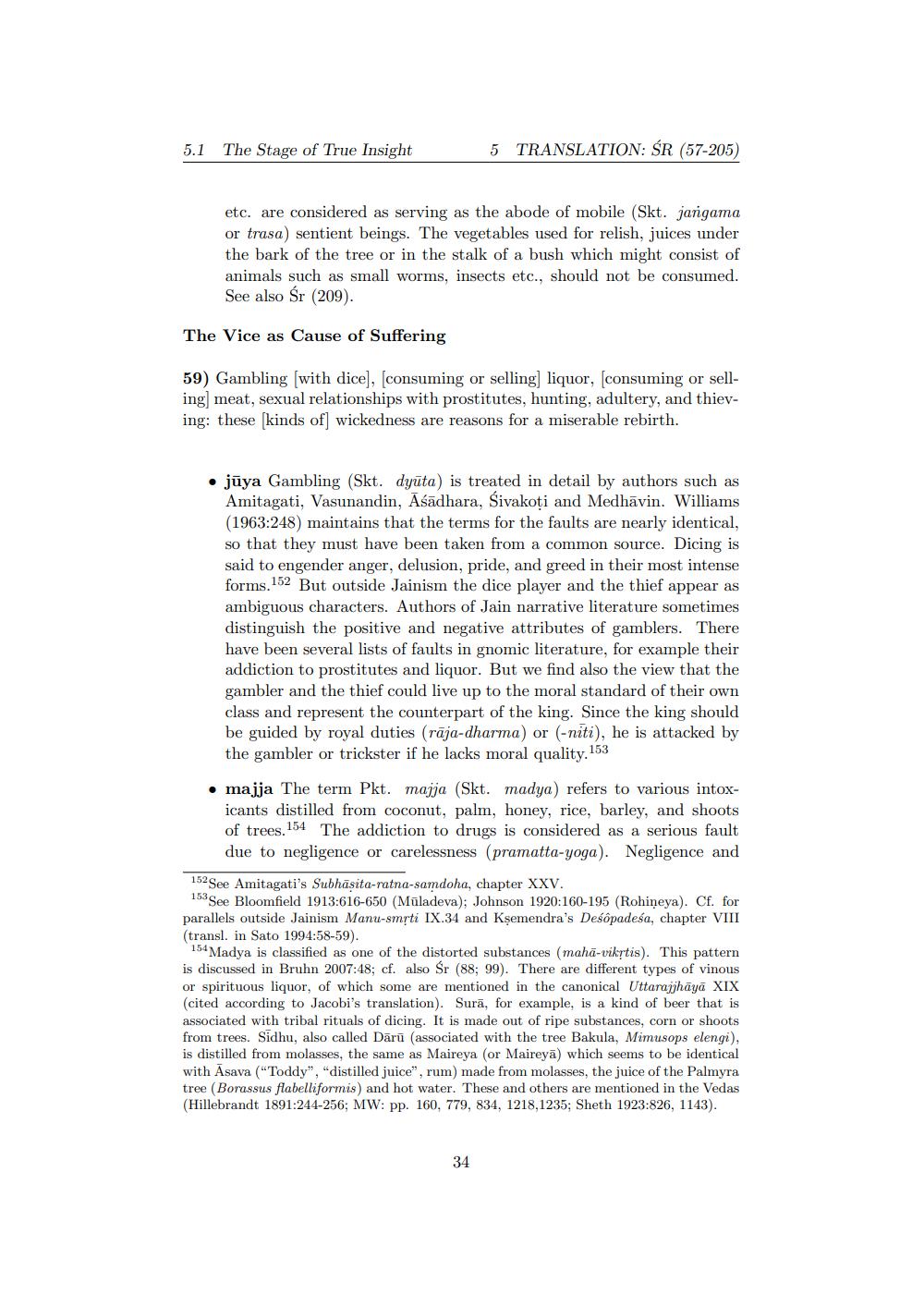________________
5.1
The Stage of True Insight
5 TRANSLATION: ŚR (57-205)
etc. are considered as serving as the abode of mobile (Skt. jangama or trasa) sentient beings. The vegetables used for relish, juices under the bark of the tree or in the stalk of a bush which might consist of animals such as small worms, insects etc., should not be consumed. See also Śr (209)
The Vice as Cause of Suffering
59) Gambling with dice, consuming or selling liquor, consuming or selling) meat, sexual relationships with prostitutes, hunting, adultery, and thieving: these kinds of] wickedness are reasons for a miserable rebirth.
• jūya Gambling (Skt. dyūta) is treated in detail by authors such as Amitagati, Vasunandin, Asadhara, Sivakoti and Medhāvin. Williams (1963:248) maintains that the terms for the faults are nearly identical, so that they must have been taken from a common source. Dicing is said to engender anger, delusion, pride, and greed in their most intense forms. 152 But outside Jainism the dice player and the thief appear as ambiguous characters. Authors of Jain narrative literature sometimes distinguish the positive and negative attributes of gamblers. There have been several lists of faults in gnomic literature, for example their addiction to prostitutes and liquor. But we find also the view that the gambler and the thief could live up to the moral standard of their own class and represent the counterpart of the king. Since the king should be guided by royal duties (rāja-dharma) or (-niti), he is attacked by the gambler or trickster if he lacks moral quality. 153
. majja The term Pkt. majja (Skt. madya) refers to various intox
icants distilled from coconut, palm, honey, rice, barley, and shoots of trees. 154 The addiction to drugs is considered as a serious fault due to negligence or carelessness (pramatta-yoga). Negligence and
152 See Amitagati's Subhāṣita-ratna-samdoha, chapter XXV. 153 See Bloomfield 1913:616-650 (Mūladeva): Johnson 1920:160-195 (Rohineya). Cf. for parallels outside Jainism Manu-smrti IX.34 and Kşemendra's Deśôpadeśa, chapter VIII (transl. in Sato 1994:58-59).
154 Madya is classified as one of the distorted substances (mahā-vikytis). This pattern is discussed in Bruhn 2007:48; cf. also Sr (88; 99). There are different types of vinous or spirituous liquor, of which some are mentioned in the canonical Uttarajjhāyā XIX (cited according to Jacobi's translation). Surā, for example, is a kind of beer that is associated with tribal rituals of dicing. It is made out of ripe substances, corn or shoots from trees. Sidhu, also called Dārā (associated with the tree Bakula, Mimusops elengi), is distilled from molasses, the same as Maireya (or Maireyā) which seems to be identical with Asava ("Toddy", "distilled juice", rum) made from molasses, the juice of the Palmyra tree (Borassus flabelliformis) and hot water. These and others are mentioned in the Vedas (Hillebrandt 1891:244-256; MW: pp. 160, 779, 834, 1218,1235; Sheth 1923:826, 1143).
34




